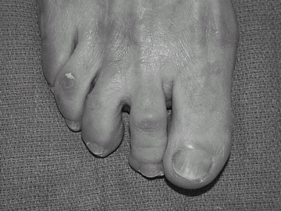Hammer Toes
Editors: Frassica, Frank J.; Sponseller, Paul D.; Wilckens, John H.
Title: 5-Minute Orthopaedic Consult, 2nd Edition
Copyright ©2007 Lippincott Williams & Wilkins
> Table of Contents > Hammer Toes
Hammer Toes
Clifford L. Jeng MD
Description
-
The term “hammer toe” describes a flexion deformity of the PIP joint of the lesser toes (Fig. 1).
-
It may be a flexible or rigid deformity.
General Prevention
Because the most common cause of hammer toes is poor
shoe wear with a tight, narrow toe box, the best prevention is to wear
shoes with a wide, high toe box that does not constrain the forefoot
area.
shoe wear with a tight, narrow toe box, the best prevention is to wear
shoes with a wide, high toe box that does not constrain the forefoot
area.
Incidence
More common in females than in males
Etiology
-
Most commonly from poorly fitting shoes
-
Neuromuscular disease
-
Diabetes mellitus
-
Inflammatory arthropathy
-
Compartment syndrome
Associated Conditions
-
Hallux valgus
-
MTP dorsiflexion deformity (claw toe)
 Fig. 1. Clinical photograph of hammer toe deformity.
Fig. 1. Clinical photograph of hammer toe deformity.
Signs and Symptoms
-
Dorsal prominence over the lesser-toe PIP joints
-
Toe may be erythematous from shoe irritation.
-
Overlying callus may be present from pressure of the shoe on the toe.
History
-
Patients complain of pain over the dorsal prominence of the hammer toe with shoe wear.
-
Patients also may have pain under the metatarsal heads (metatarsalgia).
Physical Exam
-
Determine if the flexion deformity of the toe is flexible or rigid.
-
Determine if an associated dorsal subluxation of the MTP joint is present.
-
Look for an associated hallux valgus deformity (bunion).
Imaging
Plain radiographs of the foot show the flexion deformity of the PIP joint of the lesser toes consistent with the examination.
Differential Diagnosis
-
Claw toes have a concomitant dorsiflexion deformity of the MTP joint.
-
Mallet toes have a flexion deformity at the DIP joint.
General Measures
-
If the deformity is flexible, a Budin splint may help straighten the dorsal prominence of the toe and diminish symptoms.
-
If the deformity is rigid, then padding,
including “doughnut” pads, and silicone gel toe sleeves help decrease
pressure over the dorsal prominence.
Geriatric Considerations
-
Hammer toes are a common diagnosis in elderly females.
-
In patients with coexisting morbidities,
such as diabetes or peripheral vascular disease, nonoperative
management should be exhausted before considering surgery.
Surgery
-
For flexible hammer toes, a flexor-to-extensor tendon transfer may be used to correct the deformity (1).
-
Resection arthroplasty of the distal end of the proximal phalanx with pinning can straighten a rigid hammer toe (2,3).
-
PIP fusion (4):
-
Is an alternative option for treating painful hammer toes
-
Can be used for primary surgery or for revision surgery on recurrent deformities
-
P.163
Disposition
Issues for Referral
-
Patients for whom nonoperative interventions, such as padding or splinting, fail may require surgical consultation.
-
Diabetic patients need early consultation to prevent the development of neuropathic ulceration.
Prognosis
Hammer toes usually worsen over time, with increasing deformity and pain.
Complications
-
Complications of surgical treatment include:
-
Stiffness
-
Wound infection
-
Persistent pain
-
Failure to correct deformity adequately
-
Recurrence
-
References
1. Barbari SG, Brevig K. Correction of clawtoes by the Girdlestone-Taylor flexor-extensor transfer procedure. Foot Ankle 1984;5:67–73.
2. Coughlin MJ, Dorris J, Polk E. Operative repair of the fixed hammertoe deformity. Foot Ankle Int 2000;21:94–104.
3. O’Kane
C, Kilmartin T. Review of proximal interphalangeal joint excisional
arthroplasty for the correction of second hammer toe deformity in 100
cases. Foot Ankle Int 2005;26:320–325.
C, Kilmartin T. Review of proximal interphalangeal joint excisional
arthroplasty for the correction of second hammer toe deformity in 100
cases. Foot Ankle Int 2005;26:320–325.
4. Lehman DE, Smith RW. Treatment of symptomatic hammertoe with a proximal interphalangeal joint arthrodesis. Foot Ankle Int 1995;16:535–541.
Additional Reading
Cahill BR, Connor DE. A long-term follow-up on proximal phalangectomy for hammer toes. Clin Orthop Relat Res 1972;86:191–192.
Coughlin MJ, Mann RA. Lesser toe deformities. In: Coughlin MJ, Mann RA, eds. Surgery of the Foot and Ankle, 7th ed. St. Louis: Mosby, 1999:320–391.
Coughlin MJ. Lesser toe abnormalities. Instr Course Lect 2003;52:421–444.
Myerson MS, Shereff MJ. The pathological anatomy of claw and hammer toes. J Bone Joint Surg 1989;71A:45–49.
Taylor RG. The treatment of claw toes by multiple transfers of flexor into extensor tendons. J Bone Joint Surg 1951;33B:539–542.
Codes
ICD9-CM
735.4 Hammer toe
FAQ
Q: What are simple nonsurgical measures to relieve symptoms of painful hammer toes?
A:
Shoes with low heels and a wide toe box are recommended to relieve
pressure. Taping or strapping devices may improve alignment, whereas
foam or gel pads can relieve focal pressure or calluses caused by the
shoe.
Shoes with low heels and a wide toe box are recommended to relieve
pressure. Taping or strapping devices may improve alignment, whereas
foam or gel pads can relieve focal pressure or calluses caused by the
shoe.
Q: What is the key physical finding of hammer toes?
A:
Determining the flexibility or rigidity of hammer toes is crucial to
determining nonoperative treatment options and surgical strategies.
Determining the flexibility or rigidity of hammer toes is crucial to
determining nonoperative treatment options and surgical strategies.
